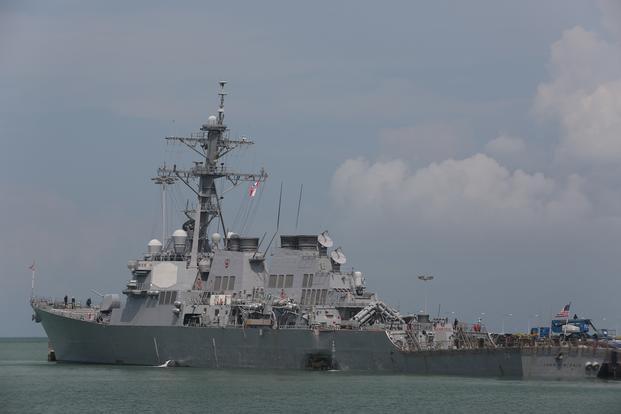As the U.S. Navy continues to search for 10 sailors missing after a destroyer collided with a merchant ship near Singapore, the chief of naval operations has directed a sweeping review of safety procedures and training and called on all commands around the globe to observe an operational pause.
The collision of the guided-missile destroyer USS John S. McCain with a Liberian-flagged merchant vessel early Monday morning local time was the second major ship collision of the summer for the Navy, following the June 17 collision of the destroyer USS Fitzgerald with a Philippine-flagged container ship southwest of Tokyo, which resulted in the deaths of seven sailors.
Within the last year, there have been a series of other high-profile mishaps in the Pacific, including the collision of the guided-missile cruiser USS Lake Champlain with a Korean fishing vessel in May and the February grounding of the cruiser USS Antietam in Tokyo Bay.
Related content:
- 10 Sailors Missing, 5 Injured After Destroyer Collides with Tanker
- Navy Fires Commander, XO From USS Fitzgerald for Fatal Collision
- US Navy Ship Collides With South Korean Fishing Boat
In a video posted to his Facebook page Monday, Adm. John Richardson said he was "devastated and heartbroken" to hear about the collision of the McCain. But while he emphasized that the Navy's primary focus was on attending to the safety of the destroyer's crew, he added that the trend of mishaps in the region called for "more forceful action."
Richardson said he directed an operational pause be taken in all fleets around the world and that a comprehensive review be launched that examines the training and certification of forward-deployed forces as well as a wide span of factors that may have contributed to the recent costly incidents.
"I want our fleet commanders to get together with their leaders and their commands to make sure that we're taking all appropriate immediate actions to safe and effective operations around the world," Richardson said.
Adm. Phil Davidson, the commander of U.S. Fleet Forces command, will lead the review, Richardson said. While he did not give a deadline for its completion, he said it would be conducted on a tight timeline, with frequent updates provided both to him and to broader military leadership.
"We will examine the process by which we train and certify our forces that are forward-deployed in Japan to make sure that we are doing everything we can to make them ready for operations and warfighting," he said. "This will include but not be limited to looking at operational tempo, trends in personnel, materiel, maintenance and equipment. It will also include a review of how we train and certify our surface warfare community including tactical and navigational proficiency."
The review will involve the Naval Inspector General's office, the Naval Safety Center, and outside input from the private sector and other services, Richardson said.
Richardson's announcement comes just hours after the most recent incident involving the McCain, but not before the collision drew critical speculation about the Navy's competence. In an editorial posted Monday on China Daily, the publication cited the recently released investigation into the Fitzgerald collision, which faulted "poor seamanship and flaws in keeping watch."
"The US Navy, which likes to claim its presence can help safeguard 'freedom of navigation' in the South China Sea, is proving to be an increasing hindrance to ships sailing in Asian waters," the editors wrote.
Richardson said the Navy plans to take swift corrective action pending the results of the safety review.
"We need to get to the bottom of this," he said. "So let's get to it."
-- Hope Hodge Seck can be reached at hope.seck@military.com. Follow her on Twitter at @HopeSeck.




























